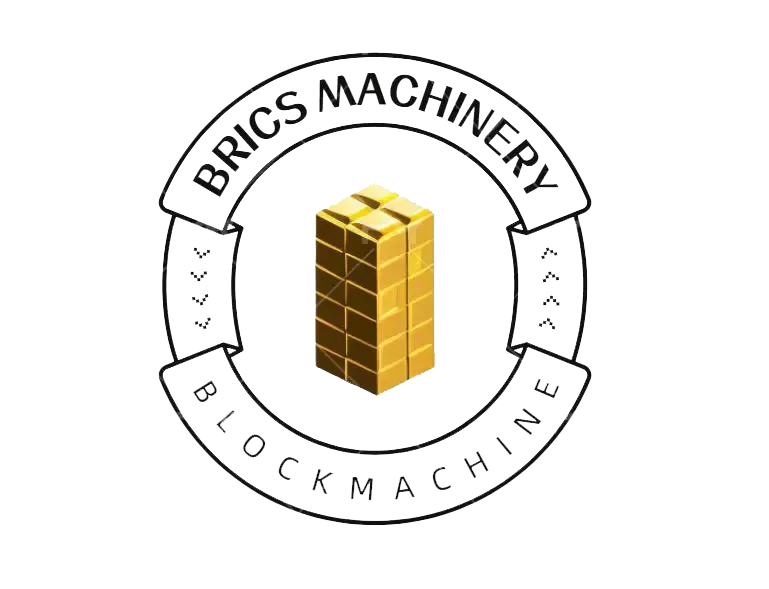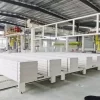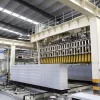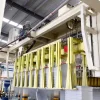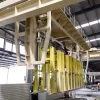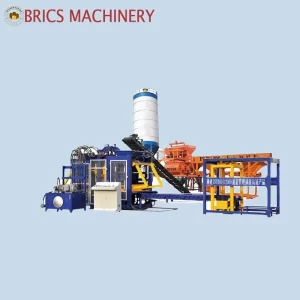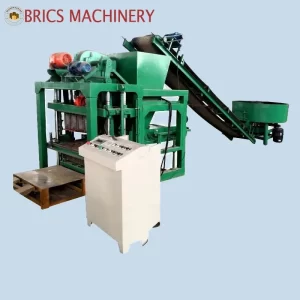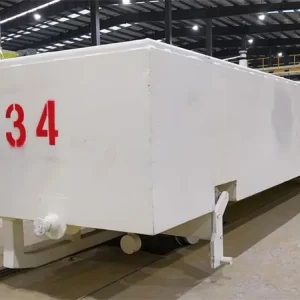FLY ASH AAC BLOCK PLANT
Description
FLY ASH AAC Block production line has the following characteristics:
RAW MATERIAL PROCESSING
The process involves an extensive grinding of quicklime, cement, gypsum, and aggregate (such as fly ash) to achieve a specific surface area fineness of 4000 cm²/g or higher. This deep grinding enhances the participation of active ingredients in the chemical reactions, resulting in improved strength for autoclaved aerated blocks. Additionally, the thorough grinding of these materials leads to the preparation of a more viscous slurry from the raw ingredients, which, in turn, enhances the stability of the pouring process.
PLC AUTOMATIC BATCHING SYSTEM
The automatic batching control system boasts a user-friendly interface, straightforward operation, high intelligence level, and a stable, reliable performance with a simple system configuration.
In the production of aerated blocks, lime, cement, gypsum, aluminum powder, and fly ash constitute the primary ingredients. Lime and cement act as binders, gypsum serves as a hardener, and aluminum powder functions as an air agent. The microcomputer control system precisely regulates the proportions of these ingredients. Following a set timeframe, the mixing tank automatically discharges the mixture. An empty signal is triggered upon completion of the discharge, initiating the operation of the transport reamer. Simultaneously, the stirring of aluminum powder commences. If the mixing tank temperature aligns with the requirements, automatic feeding of lime and cement ensues. Once lime and cement feeding is complete, a scale empty signal is generated.
After a specific duration, the transport reamer halts its operation. Subsequently, after another period, the aluminum powder stirring automatically resumes, coinciding with the automatic feeding of aluminum powder. Following a designated timeframe, the mixer halts, and the pouring phase begins. Upon completion of this work cycle, the system awaits the next set of instructions. It’s worth noting that the feeding of the measuring scale (from the silo or slurry tank to the metering tank) and feeding are interlocked. Only after one feeding process is completed can the other commence; simultaneous feeding is strictly prohibited.
POURING PROCESS
The cutting machine holds a pivotal role within the AAC production line and has consistently been a focal point for research and enhancement at Our company’s Technology Center.
Traditionally, cutting machines employed a vibration-based cutting mechanism, which, while enhancing labor efficiency, suffered from complicated operation and significant cutting errors. In response, Our company’s Technology Research and Development Center developed a novel cutting unit by drawing from the conventional cutting machine and incorporating innovative design principles. This new design is heavily influenced by German WEHRHAHN technology and features key components such as the main reducer and control elements sourced from renowned domestic and international manufacturers, ensuring the stability of the end product.
Notably, the new cutting machine employs a cylinder-based tensioning system for the cross-cut steel wire and incorporates a swinging frame, leading to extended steel wire lifespan and improved cutting accuracy. One of its standout features is its mobile cutting platform, enabling the cake and cross-cutting processes to occur at a single position. As the cake transitions to the next position, both longitudinal and horizontal cutting operations can be executed seamlessly. This chain cutting machine excels in terms of automation, user-friendliness, a shortened cutting cycle, and precise steel wire cutting, reducing production times significantly and enhancing labor productivity.
AUTOCLAVE CURING SYSTEM
The proper selection of an autoclave in this manufacturing process holds significance not only for the quality of the products but also for the overall production efficiency and energy consumption.
In this system, our company utilizes a specialized autoclave with several outstanding advantages:
- The autoclave door is constructed from a single piece of Jinan Q345R steel plate and is forged integrally from 16Mn material. The primary welds on the pressurized components are carried out using submerged arc automatic welding, ensuring structural integrity and reliability.
- The autoclave door features a movable quick-opening design, which is operated by a hand reducer. It is equipped with a comprehensive safety interlock protection system, effectively preventing the occurrence of hidden operational hazards.
- Well-known domestic and international brands supply key components such as safety valves, temperature measurement devices, inlet and exhaust valves, guaranteeing the normal and safe operation of the autoclave and extending its service life. This autoclave not only offers appropriate and rational maintenance for the raw material (billet) but also accelerates the product’s attainment of its designed strength within a shorter timeframe. This approach minimizes the potential for damage to the billet and the final product, ensuring product quality and efficiency.
FINISHED PRODUCT PACKAGING PROCESS
This manufacturing process features our company’s independently developed mobile separator, which automates the final product breaking procedure, offering the following advantages:
- The mechanical structure is straightforward, making it user-friendly and easy to operate.
- In the design of the hydraulic system for the separator, individual control is established for each pair of clamps, allowing for flexible selection of the clamping and separation positions.
- To accommodate blocks of varying strength levels, the clamping force of the clamping clamp can be easily adjusted. Once the desired clamping force is set, the system will automatically halt pressure application and maintain the specified clamping force.


Related projects
JIANGSU GLOBAL VILLAGE 400000 M3/A AERATED PLATE BLOCK PROJECT
Project Name: 400,000 M3/A Aerated Board Block Engineering
Project Description: The 400,000 M3/A Aerated Board Block Engineering project is a substantial construction and engineering endeavor focused on the production or utilization of 400,000 cubic meters of aerated concrete blocks or aerated board blocks annually. These blocks are known for their lightweight nature and thermal insulation properties, making them popular choices in the construction industry.
Key Aspects of the Project:
- Production Volume:The primary objective of the project is to produce or use 400,000 cubic meters of aerated board blocks per year.
- Materials:Aerated concrete blocks are typically made from a combination of sand, cement, lime, and aluminum powder, which creates a lightweight, porous structure with good insulating properties.
- Technology and Machinery:Advanced machinery and production methods, including autoclaving (a curing process using steam and pressure), may be employed to ensure the efficient and precise manufacturing of aerated concrete blocks.
- Quality Assurance:Ensuring a high level of quality and adherence to industry standards and regulations is a critical aspect of the project.
- Market Impact:The availability of a significant volume of aerated board blocks can influence the construction industry by providing the necessary resources for various building projects, particularly those that prioritize energy efficiency and insulation.
- Environmental Considerations:The project may consider environmentally friendly production methods and materials, as sustainability is a growing concern in the construction industry.
- Applications:Aerated concrete blocks are used in a wide range of construction projects, including residential and commercial buildings, as they offer excellent insulation properties, reduce construction weight, and can improve energy efficiency.
The success of this project depends on factors such as the efficiency of production processes, the quality of the aerated concrete blocks, and the demand for such blocks in the construction market, especially in energy-efficient and sustainable building projects.

